NZXT Phantom 630 Case Review: The Relentless Pursuit of Perfection
by Dustin Sklavos on January 20, 2013 12:01 AM ESTNoise and Thermal Testing, Overclocked
A case like the NZXT Phantom 630 isn't meant to run hardware at stock settings; it's designed for end users who want to push their systems as far as they can go. My experiences with Ivy Bridge and Kepler suggest that for current generation hardware, this is especially relevant, with Kepler in particular having its boost clocks being governed by relatively low thermal thresholds.
Our overclocked testbed tends to put a healthy amount of stress on system cooling, but you're about to see the Phantom 630 hit another grand slam and obsolete its older, more expensive sibling.
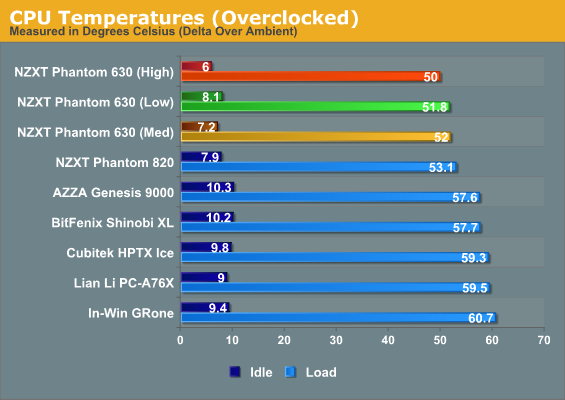
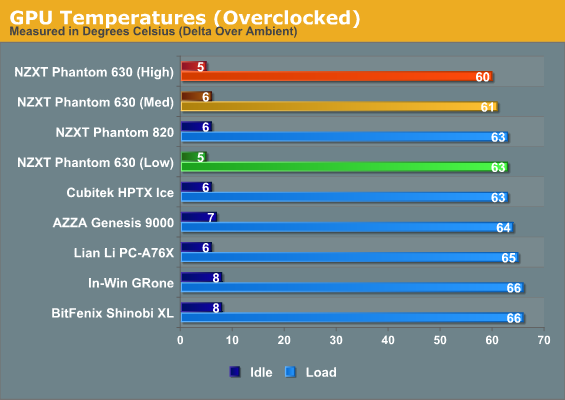
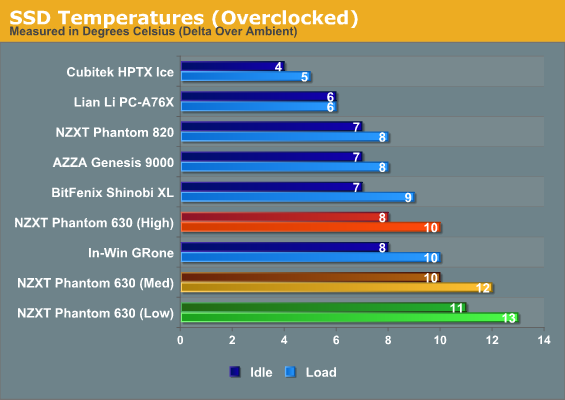
So this is pretty much what progress looks like. The SSD again runs toastier behind the motherboard tray than it does in the other enclosures, but not even close enough to affect usability; add another 10C to start approaching that threshold. If you run the Phantom 820 at its absolute highest fan setting, it can produce ever-so-slightly better CPU thermals than the 630 can, but just barely above the margin of error. The 630 just has a more efficient airflow design.

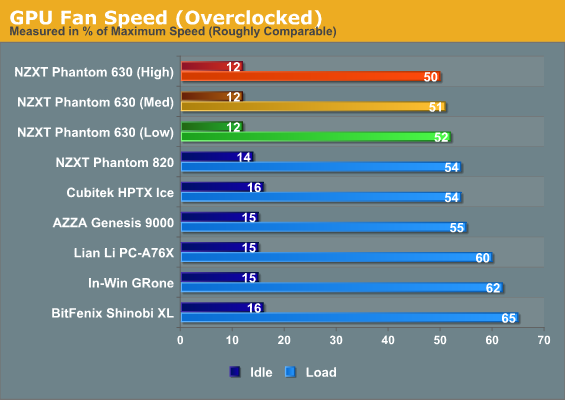
Airflow at the fan's high setting keeps the cooler on the CPU from hitting its inflection point, at which point it would have to spin up to a much higher setting. Fan headroom is still decent, but we're definitely pushing the cooling power of our CoolerMaster Hyper 212 Evo a little.
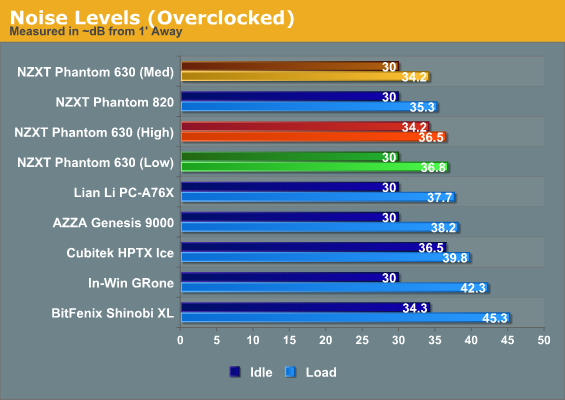
Say it with me, now: superior airflow almost always trumps acoustic padding. The Phantom 630's medium fan setting is most definitely its sweet spot, and the excellent flow through of the case keeps the heatsink fans from ever having to spin up too much. The 630 does a particularly excellent job of keeping our GTX 560 Ti cool even under its overclocked settings.










44 Comments
View All Comments
3ogdy - Sunday, January 20, 2013 - link
Oh, look these cases look so much better than NZXT's Phantom:They're awesome
http://homepages.ihug.co.nz/~wayrich/computer-hist...
http://www.vmaxcanada.com/products/case/q500.jpg
http://museumvictoria.com.au/collections/itemimage...
http://www.stsnetwork.com/imagesnojava/pc_case.gif
http://assets.overclock.net.s3.amazonaws.com/3/3f/...
With these modern and stylish cases, I still don't understnad how NZXT can make such ugly cases
/irony
lockdown571 - Sunday, January 20, 2013 - link
Yeah I don't really get all the criticisms about styling. I find most cases are either too plane or horribly gaudy. I think this strikes a nice balance. I also HATE how most computer cases leave the optical drives exposed. That's actually one of the major reasons I bought the NZXT Phantom. To each their own though.Stan Zaske - Sunday, January 20, 2013 - link
Very nice styling. Excellent functionality. Too expensive. Nice article.HisDivineOrder - Sunday, January 20, 2013 - link
That, padding, and you've got a great silent case. I do like the hd cage design where you decide if you want a lot of hd's or just the 1 SSD+ 1 HD config a lot of gamers will go for.Tech-Curious - Sunday, January 20, 2013 - link
Excellent review, as usual.Have you reviewed any interesting cases with a top-mounted PSU lately, Dustin? Any of those cases in the pipeline? Just curious.
pdjblum - Sunday, January 20, 2013 - link
Do not get why you continue to refuse to list the materials in the specifications.londiste - Monday, January 21, 2013 - link
only the single-bay drive cage was installed for the tests? how much would more drive cages affect the cooling performance?are the drive cages interchangeable, i.e. can you only use the 2-bay cage at the bottom of the case?
beepboy - Monday, January 21, 2013 - link
I wouldn't shell this much for a case that's not made out of all aluminum. 27 lbs for an empty case is a little too heavy for my taste.HardwareDufus - Monday, January 21, 2013 - link
It's the least offensive of the current crop of robot/transformer like cases. Great function...not so hott form...but then again..I recognize there is an audience for a case with these looks.Magichands8 - Thursday, January 24, 2013 - link
I know I'm a little late commenting on this so I probably wont' get any kind of response but I'm a little confused about the results for this case. I'm comparing this one with the Nanoxia DS 1. Looking at the results for the noise and thermals (CPU, overclocked) it appears that the Phantom 630 is doing a better job at cooling than the Nanoxia DS1 at the same noise levels. Then, in the review for the 630, Dustin says:"If noise is your utmost concern you're never going to really beat the Nanoxia Deep Silence 1..."
How can this be the case (ahem!) if the results show the same noise readings at the same distance?
Also, he states:
"The windowed side panel looks better than its predecessor and obviously contributes to the case's killer performance..."
How could a windowed side panel contribute to the cases performance? I would think that a solid steel side panel would be better at reducing noise and even slightly better for heat dissipation.